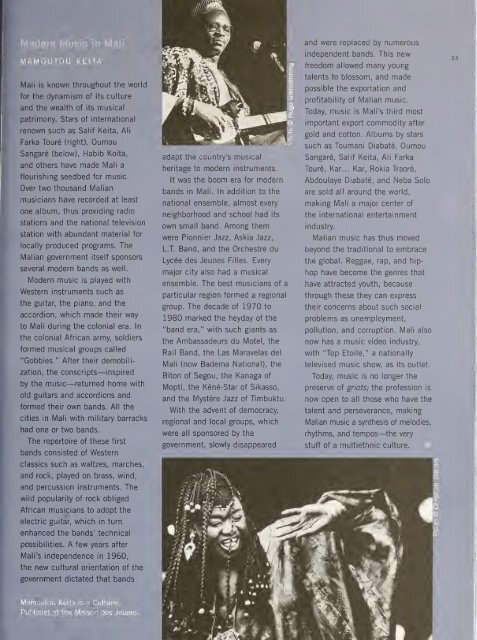SCOTLAND - Smithsonian Digital Repository - Smithsonian Institution
SCOTLAND - Smithsonian Digital Repository - Smithsonian Institution
SCOTLAND - Smithsonian Digital Repository - Smithsonian Institution
You also want an ePaper? Increase the reach of your titles
YUMPU automatically turns print PDFs into web optimized ePapers that Google loves.
w^n*<br />
iJiHiiiKm.<br />
Mali is known throughout the world<br />
for the dynamism of its culture<br />
and the wealth of its musical<br />
patrimony. Stars of international<br />
renown such as Salif Keita, Ali<br />
Farka Toure (right),<br />
Oumou<br />
Sangare (below), Habib Koita,<br />
and others have made Mali a<br />
flourishing seedbed for music.<br />
Over two thousand Malian<br />
musicians have recorded at least<br />
one album, thus providing radio<br />
stations and the national television<br />
station with abundant material for<br />
locally produced programs. The<br />
Malian government itself sponsors<br />
several modern bands as well.<br />
Modern music is played with<br />
Western instruments such as<br />
the guitar, the piano, and the<br />
accordion, which made their way<br />
to Mali during the colonial era. In<br />
the colonial African army, soldiers<br />
formed musical groups called<br />
"Gobbles." After their demobilization,<br />
the conscripts— inspired<br />
by the music—returned home with<br />
old guitars and accordions and<br />
formed their own bands. All the<br />
cities in Mali with military barracks<br />
had one or two bands.<br />
The repertoire of these first<br />
bands consisted of Western<br />
classics such as waltzes, marches,<br />
and rock, played on brass, wind,<br />
and percussion instruments. The<br />
wild popularity of rock obliged<br />
African musicians to adopt the<br />
adapt the country's musical<br />
heritage to modern instruments.<br />
It<br />
was the boom era for modern<br />
bands in Mali. In addition to the<br />
national ensemble, almost every<br />
neighborhood and school had its<br />
own small band. Among them<br />
were Pionnier Jazz, Askia Jazz,<br />
L.T. Band, and the Orchestre du<br />
Lycee des Jeunes Filles. Every<br />
major city also had a musical<br />
ensemble. The best musicians of a<br />
particular region formed a regional<br />
group. The decade of 1970 to<br />
1980 marked the heyday of the<br />
"band era," with such giants as<br />
the Ambassadeurs du Motel, the<br />
Rail Band, the Las Maravelas del<br />
Mali (now Badema National), the<br />
Biton of Segou, the Kanaga of<br />
Mopti, the Kene-Star of Sikasso,<br />
and the Mystere Jazz of Timbuktu.<br />
With the advent of democracy,<br />
regional and local groups, which<br />
were all sponsored by the<br />
government, slowly disappeared<br />
and were replaced by numerous<br />
independent bands. This new<br />
freedom allowed many young<br />
talents to blossom, and made<br />
possible the exportation and<br />
profitability of Malian music.<br />
Today, music is Mali's third most<br />
important export commodity after<br />
gold and cotton. Albums by stars<br />
such as Toumani Diabate, Oumou<br />
Sangare, Salif Keita, Ali Farka<br />
Toure, Kar... Kar, Rokia Traore,<br />
Abdoulaye Diabate, and Neba Solo<br />
are sold all around the world,<br />
making Mali a major center of<br />
the international entertainment<br />
industry.<br />
Malian music has thus moved<br />
beyond the traditional to embrace<br />
the global. Reggae, rap, and hiphop<br />
have become the genres that<br />
have attracted youth, because<br />
through these they can express<br />
their concerns about such social<br />
problems as unemployment,<br />
pollution, and corruption. Mali also<br />
now has a music video industry,<br />
with "Top Etoile," a nationally<br />
televised music show, as its outlet.<br />
Today, music is no longer the<br />
preserve of griots; the profession is<br />
now open to all those who have the<br />
talent and perseverance, making<br />
Malian music a synthesis of melodies,<br />
rhythms, and tempos—the very<br />
stuff of a multiethnic culture.<br />
electric guitar, which in<br />
turn<br />
enhanced the bands' technical<br />
possibilities. A few years after<br />
Mali's independence in 1960,<br />
the new cultural orientation of the<br />
government dictated that bands<br />
/A'<br />
Publicist at the Maison des Jeunes.l
















